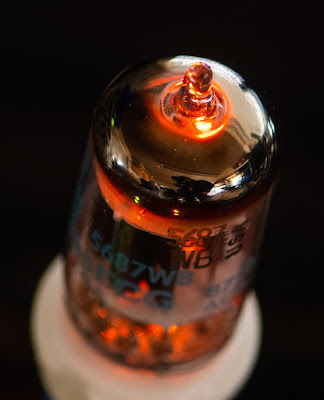Hi!
The Noval base (miniature 9 pin) tubes are somewhat underrepresented in this series. Less than 10 covered so far. So let's pick one for this month. Meet the 5687.
The 5687 is a double triode wich was designed as a general purpose tube. Both triode systems are identical and are of the medium mu variety.

The 9 pin base is shown on the left. The heater has a center tap which allows both 6.3V and 12.6V operation. When the heater voltage is applied to pins 4 and 5 it consumes 450mA at 12.6V. This is the series connection. Pins 4 and 5 can also be tied together and the center tap of the heater which is connected to pin 8 used as the other terminal. Then it becomes a 6.3V heater which needs 900mA of current. Both triode systems have an amplification factor of 17 and a plate resistance of about 3kOhm. This puts one half of the 5687 in the vicinity of a 6SN7 with both sections connected in parallel. It just has a tad less amplification factor. Quite an interesting tube actually. The 5687 enjoyed some popularity among tube amplifier builders 20 years ago but seemed to have been forgotten. It could be very useable in a linestage and also as a driver for power tubes.

The maximum plate dissipation per triode is 4.2W, which reduces to 7.5W max for both halves together. That is pretty hefty for such a small tube. Both systems connected in parallel would yield a small output tube for driving headphones or for an ultra low power amplifier. With its lowish plate resistance the tube could be easily used with interstage or output transformers, especially when both triodes are wired in parallel. For a complete set of technical specs see the
data sheet. Quite remarkable why it fell a bit out of fashion. But I admit I myself ignored this tube so far. But maybe this will change sometime in the future. Since I never used this tube type I do not have many samples, only 10 pieces and all of them are made by the same manufacturer. As always let's have a look at the plate curves first. Here the set of curves from the data sheet:
And the measured curves:
All the 5687 I have are made by Philips ECG (formerly Sylvania):
The 5687 was intended for industrial use. Industrial tubes were given a 4 digit type number. The prefix JAN on the tubes shown stands for Joint Army Navy. So these had been manufactured for the military.
They were packed in the typical plain white boxes of the military. The date code indicates these have been made in the 1980ies. Although the date on the box is a packed date and not necessarily the manufacture date of the tube. But it is most likely the tubes had been made around the same time.
The W-suffix indicates a ruggedised type and the B-suffix a revision in maximum ratings or some other specs. But I did not find any information about what has been changed in the B-version.
Enjoy some views of the tube from all angles.
Some close ups:
Quite an impressive little gem!
Let's see how the tube looks in operation!
Since I only have ten 5687 tubes and all of them measure good, I did not want to sacrifice one to show the internal construction. Instead I took some more photos from various angles and some close ups.
I hope you enjoyed this months tube presentation.
Best regards
Thomas


















































